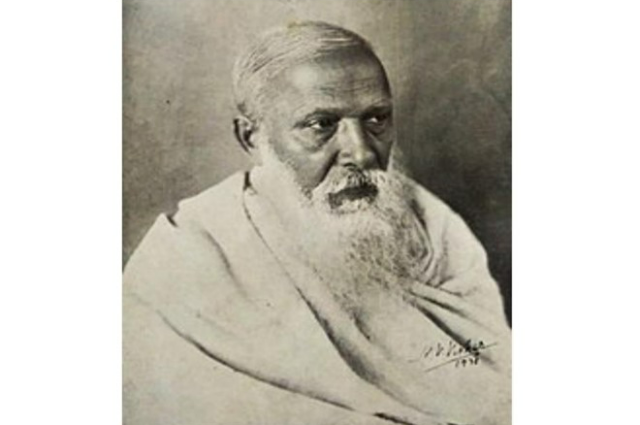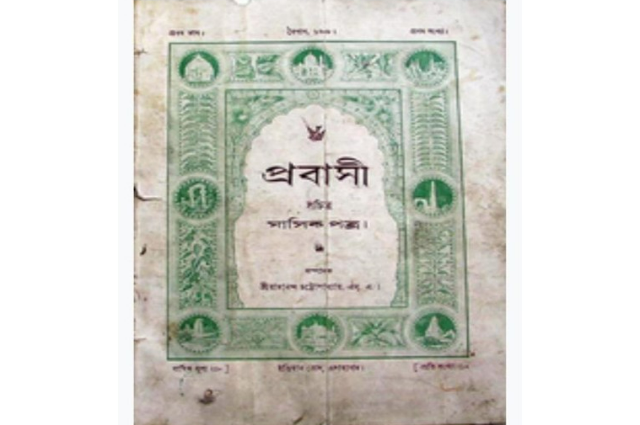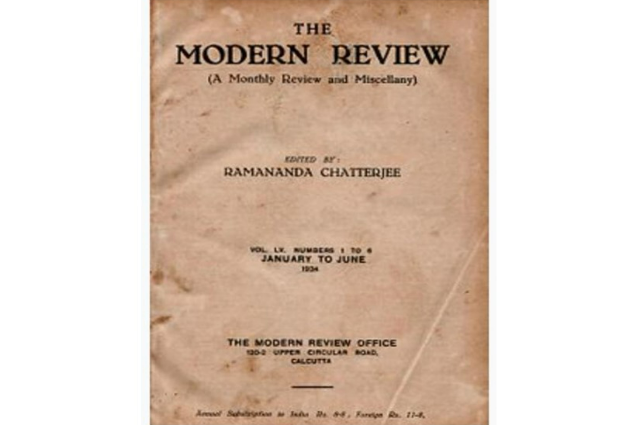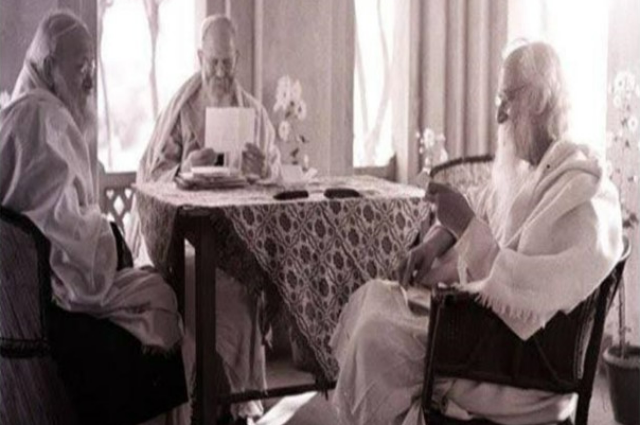Introduction:

Source: Wikipedia
A venerable Brahmosamaji gentleman with white flowing beard during a session of the General Assembly of the League of Nations in Geneva was mistaken for Rabindranath Tagore. He was none other than Ramananda Chattopadhaya, veritably the most influential editor during the colonial rule in India. He is regarded as the Father of Indian Journalism for his oceanic and versatile erudition and landmark contribution in the field of honest, intellectual and courageous journalism.
Life and Education:
Ramananda Chatterjee belonging to a Bengali middle class family was born at Pathakpara at Bankura on 29th May, 1865. He was all along a bright student. He received primary education in a vernacular school and passed Student-Scholarship Examination from Bankura Banga Vidyalaya in 1875. He passed the Entrance from Bankura Zilla School in 1883. He did F.A. from St. Xavier’s College in 1885. Then he joined City College. He was the first rank holder of University of Calcutta in the B.A in 1888 and won the prestigious Ripon Scholarship of Rs. 50 per month. In 1890, Mr. Chatterjee post graduated in English from University of Calcutta. A deep sense of nationalism ingrained in him because of his heartfelt attraction towards the patriotic poems of Rangalal Bandyopadhayay. He rendered service as a lecturer at the City College in Calcutta. Later he assumed the chair of Principal of Kayastha Pathshala in Allahabad in 1895.Editor of Journals:
Heramba Chandra Maitra, the editor of Indian Messenger, appointed him as the assistant editor of the mouthpiece of Sadharan Brahmo Samaj in 1890 paving the way of his career in journalism. From then on his journey as an editor, journalist and writer continued unabated. He earned much acclaim for his two journals Prabasi in April 1901 and The Modern Review in 1907. Besides, he also launched Vishal Bharat, a Hindi Journal to cover the Hindi language readers in the Hindi region, in 1928. He was also indissolubly linked for his editorship with four more journals including Dharmabandhu, Dasi, Pradeep and Mukul for a long period. He also wrote some books in Bengali and in English. He authored “Towards Home Rule” in 1917. During the first half of the 20th century, his unequivocal contribution in the amelioration of Bengali literature cannot be denied.Prabasi, a Bengali Journal:

Source: Wikipedia
Ramananda Chatterjee is considered the most influential Indian Editor during the colonial era. His monthly Bengali journal Prabasi launched in 1901 earned tremendous popularity from its inception with the circulation of around 7500 in early 1920s. Literacy rate in the country was then woefully low. Rabindranath Tagore, one of the most prominent contributors, was associated with the journal for about four decades. His novels, poems and essays would be published in Prabasi regularly. A substantial amount was paid in advance to Tagore for his serialized fiction “Gora”, the fifth and longest novel of his. Naturally, a sweet bonhomie was established between Tagore and Chatterjee.
Besides Rabindranath, hundreds of eminent writers including Bhibhutibhushan Bandyopadhyay, Premendra Mitra, Nirod C. Choudhuri, Sarasibala Basu et al contributed different types of writings in the Bengali periodical. Not only literary figures but also great historians and scientists like Rakhaldas Bandyopadhyay, Jadunath Sarkar, Sir Jagadish Chandra Bose, Acharya Prafulla Chandra Roy and others elevated the standard of the monthly journal to an envious position. The journal catered to a variety of tastes and choices of its readers covering articles on science, history, sociology, economy, politics philosophy, archaeology, arts and so on.
The Modern Review, an English Journal:
Another highly esteemed publication of Mr. Chatterjee was The Modern Review, an English-language journal, started its majestic gait in 1907. The monthly magazine with a broadly nationalistic outlook emerged as an important forum for the Indian Nationalist intelligentsia. Besides essays on politics, economics, sociology, the magazine would be replete with literary elements including poems, stories, travelogues and sketches. The English-knowing elite Indians were the targeted readers of The Modern Review. However, the British people in colonial India and abroad went through the journal to be acquainted with the contemporary issues of colonial India.
Source: Wikipedia
A galaxy of great personalities contributed their articles regularly in The Modern Review. They were Subhas Chandra Bose, Mahatma Gandhi, Jawaharlal Nehru, Sister Nivedita, Verrier Elwin, Lala Lajpat Rai, C.F. Andrews, Rev. Jabez T. Sunderland and others. The historic essay entitled “Rashtrapati” emphasising on the importance of questioning the motives of leaders and checking the power they held written by Jawaharlal Nehru under the pseudonym Chanakya describing himself as “some triumphant Caesar passing by” who might turn dictator with “a little twist” was published in The Modern Review in 1937. The article stirred across India. All these indicated the high stature of the magazine. Under his masterly guidance, both the periodicals not only promoted the stature of Indian journalism but also symbolized the pillars of strength in the cause of Indian struggle.
Ramananda Chatterjee’s journals gained popularity for his staunch criticism against the injustices of the British government without any political biases. Needless to say, he had to pay a price as a result of his criticism of the government. He had to leave Allahabad as he was directed to stop publishing The Modern Review by the British authority in 1908. Chatterjee was arrested on charges of sedition for the publication of the book “India in Bondage: Her Right To Be Free” written by the American Unitarian Jabez T Sunderland, an outspoken activist for human rights and anti-imperialism. Mr. Chatterjee believed that without ownership no editor could enjoy freedom of the press absolutely.
Ardent Nationalist and Liberal:
Mr. Chatterjee was an ardent nationalist and liberal as well. His nationalism was not tainted with casteism, communalism or any sort of parochial prejudice. He was committed to democracy with social and economic equality. He endeavoured to break the myths that the colonial rulers had ingrained for centuries that they belonged to ‘superior races’ and ‘superior civilizations’. Therefore, he took special initiatives to promote Indian culture, art and literature that were then regarded as grotesque and without aesthetic values. Therefore, Mr. Chatterjee sought the help of the renowned Ceylonese art critic and art philosopher Ananda Coomaraswamy to defend Oriental art. Besides, the paintings of renowned artists including Nandalal Bose, Asit Kumar Haldar and Debi Prasad Roy Choudhury would be reproduced in The Modern Review and Prabasi. The cover of the journal Prabasi contained geometrical blocks of India’s architectural marvels including Taj Mahal, Gate of Sanchi, Qutub Minar, Buddhish Vihar of Bodh Gaya, the Golden Temple, the Lingaraj Temple and the Burmese Pagoda,Ramananda Chatterjee had unwavering advocacy for women education and liberation. According Nirod C. Choudhury who served as an assistant editor of The Modern Review, Mr. Chatterjee had a fixed dogma that a woman could do no wrong even for political reasons. Mr. Chatterjee in his two popular magazines published the educational and professional achievements of all Indian women with photographs of the heroines.
Conclusion:

Source: Pinterest
Ramananda Chatterjee was not a man of compromise. When he visited Europe on an invitation from the League of Nations, he declined to accept the monetary assistance of Rs 6,000 for his unwavering commitment to freedom of speech and expression. He did not support the Gandhi-Ambedkar pact of 1933 as he thought it “detrimental to the broader interest of the country”. Despite his close friendship with Tagore, he diametrically opposed him in the Vande Mataram controversy. Our country feels the need of editors like Mr. Chatterjee when India’s ranking in the 2022 World Press Freedom Index has plummeted to 150 out of 180 countries, according to the latest report released by the global media watchdog, Reporters Without Borders.
. . .
Bibliography:
- Ramananda Chatterjee, A Voice in the Void by Kalyan Chatterjee
- Editor par Excellence: By Dileep Padgaonkar
- We Want No Caesars: Nehru’s Warning to Himself
- With Contributors Like Nehru & Bose, This Editors Work has Lessions for Modern India by Rinchen Norbu Wangchuk
- The star of intellectual journalism by Niranjan Rajadhyaksha
- Press & Nationalism by Subrata Mukherjee
- Babu Ramananda Chatterji by Rangildas Kapadia
- The Science Communicator – Ramananda Chattopadhyay
- Ramananda Chatterjee First Issue of Prabasi
- An Issue of The Modern Review Ramananda Chatterjee with Rabindranath
